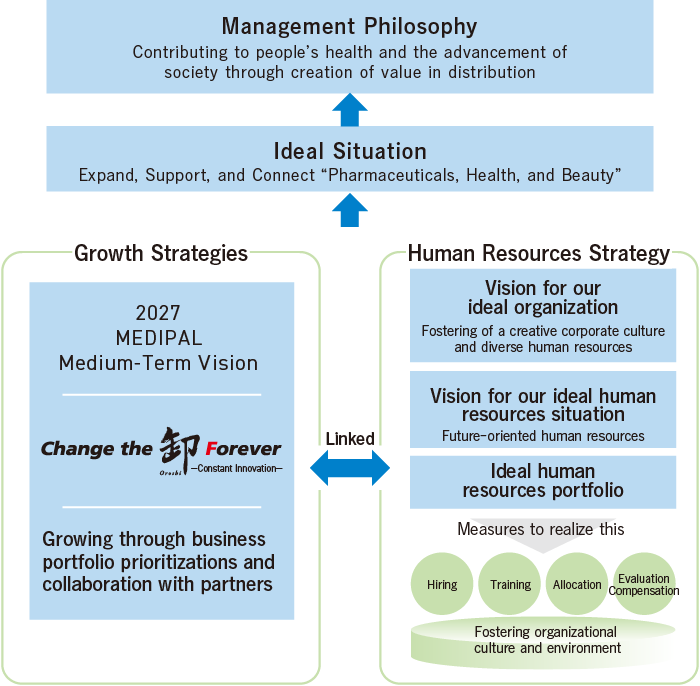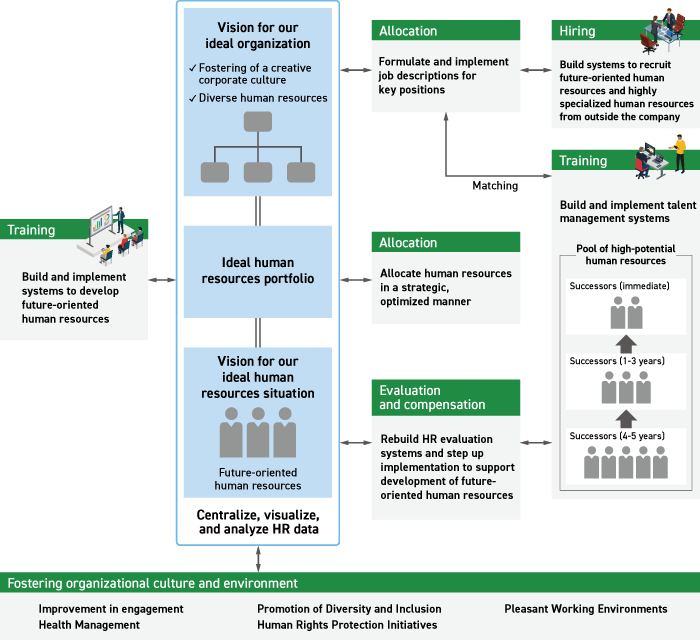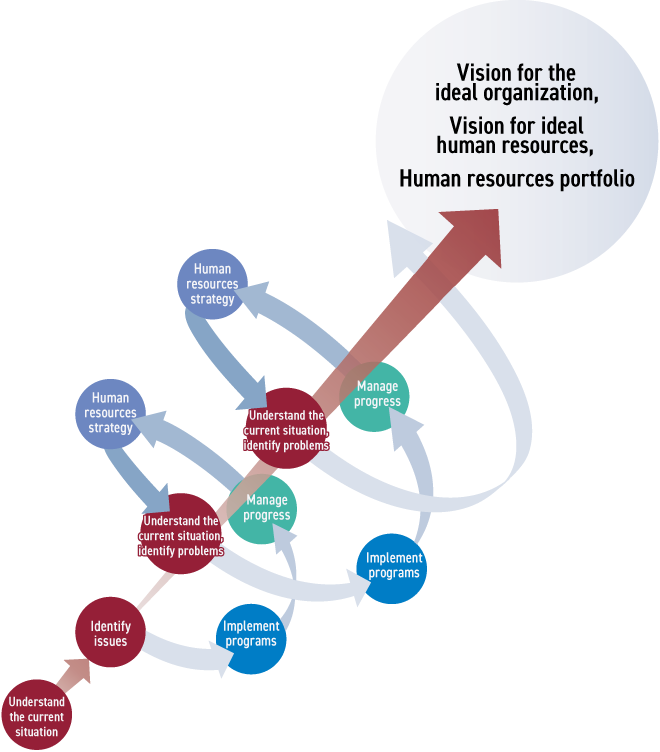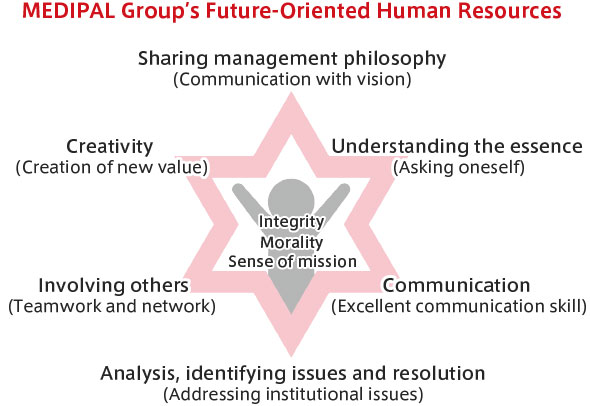Human Resources Strategy
As we work to achieve our “ideal situation” and our 2027 MEDIPAL Medium-Term Vision: “Change the Oroshi Forever: Constant Innovation”, the MEDIPAL Group considers human resources to be the source of our competitive edge and corporate value, so we are pursuing a human resources strategy linked with our growth strategy.
Our employees across the MEDIPAL Group are a diverse group of people but they share the common value of “integrity,” “morality,” and a “sense of mission.” We are executing a human resources strategy that nurtures their individual personalities, capabilities, and strengths. We actively invest in our people to identify and draw out the potential value of our human capital, and we work to orchestrate our resources as a diverse team full of potential, which will lead to sustainable improvements in corporate value.
Human Resources Strategy Positioning
To create social value and customer value and to ensure sustainable growth for the Group, we are focusing on a human resources strategy that links with our growth strategy to achieve our ideal situation, and will reflect this in our programs. Specifically, we have defined the ideal situation for both our organization and our human resources and are developing a human resources management program to build the ideal human resources portfolio to achieve our ideal situation.
Through this, the MEDIPAL Group will continue to contribute to people’s health and the advancement of society by thinking proactively and constantly evolving, no matter what changes we face in the operating environment.


Disseminating and Realizing our Vision for Ideal Organization and Ideal Human Resources
In order to realize the vision we have for our ideal organization and ideal human resources, we have opened up various communication channels to further everyone’s understanding, including opportunities for direct interaction between management and employees, and are drafting and executing human resources management action plans for each function with an emphasis on employee initiative and autonomy.
Realizing the Ideal Human Resources Portfolio
To shift to a business portfolio that will allow us to achieve the 2027 MEDIPAL Medium-Term Vision, we need to match the right person to the right job position. In our core businesses, we aim to increase added value and productivity while also achieving further growth. In order to shift human resources into what we now define as priority businesses, such as new businesses, medical devices and reagents, or AGRO & FOOD, we will analyze the current human resources portfolio for each business and design and visualize targets in order to execute our human resource strategy for both quantity and quality. We will enable faster business decisions and constant innovation by pursuing a human resources strategy to take us into the future. This will allow us to build systems to create social value and customer value and to achieve sustainable growth by the Group.
Systems to Implement our Strategy
To pursue this strategy, our Human Resources Strategy Department is working out the concept and direction of the human resources strategy for the Group and developing platforms and other programs for overall management. After laying the groundwork in this way, the actual programs are handed over for the administrative and HR departments of each company to actually implement. We have set up a Human Resources Committee as the organization responsible for liaising and coordinating between the Human Resources Strategy Department and the HR divisions of each company. This committee meets monthly to share, investigate, and discuss problems, policies, and actions. The strategies and measures decided by the committee are reported to the management levels as needed.
Human Resources Committee in FY2023
- Number of meetings held: 11
- Main discussion points
- Building an evaluation system and confirming progress on projects
- Sharing the analysis of results from the survey of workplace culture and considering how to utilize the results
- Considering a human resources training program for the next generation of management and key positions
- Considering how to utilize the talent management system
Roadmap
To realize our vision for the the ideal organization and ideal human resources and to develop our human resources portfolio, we will implement the foundation building phase and the execution phase in parallel.
- Understand the current situation and identify problems
To be able to put this human resources portfolio management into practice, we will work to understand where we are now in terms of what skills our human resources have, where these resources are, and how much resource we have. In parallel, we will also run a survey of our workplace culture to identify any problems. - Implement programs and build a human resources platform
Reflecting on both the problems identified (current situation) and the vision (target), we will implement programs and build a human resources platform.- Centralize, visualize, and analyze HR data
- Build systems to recruit future-oriented human resources and highly specialized human resources from outside the company
- Build and implement talent management systems
- Systematize reskilling
- Build and implement systems to develop future-oriented human resources
- Formulate and implement job descriptions for key positions
- Allocate human resources in a strategic, optimized manner
- Rebuild HR evaluation systems and step up implementation to support development of future-oriented human resources
- Manage progress based on KPIs
As we implement the foundation building phase and the execution phase in parallel, in line with our human resources strategy, we will set KPIs for our human resources strategy to manage our progress. To set the KPIs, we are drawing on the ISO 30414 standard and considering developing KPIs specific to the MEDIPAL Group that link with our growth strategy.

Centralize, Visualize, and Analyze HR Data
The MEDIPAL Group introduced a talent management system in April 2023 for more advanced management of human resources. Centralizing the information on human resources possessed by each company in this system has enabled us to integrate and visualize information for the entire Group. Going forward, we will centralize, visualize, and analyze various HR data, including in-depth work experience and qualifications for individual employees, the skills they possess, and their career plans. This system will allow us to place the right person in the right job position. At the same time, the system provides status reports on employee numbers and sufficiency of suitable human resources for particular roles, and we aim to use this information to build a human resources portfolio that links with our business strategies.
Human Resource Requirements
- Common Values
For its human resources, the MEDIPAL Group places great importance on integrity, morality, and a sense of mission as common values and considers these qualities to be the foundations of decision making.
Integrity: Always take a sincere approach and behave with fairness and honesty.
Morality: Act with general common sense as well as in compliance with laws and industry rules.
Sense of mission: Take responsibility and behave in accordance with what is right for the organization and oneself. - For the future of the MEDIPAL Group, we have defined six requirements for the future-oriented human resources to strengthen our business foundations, drive transformation, and develop our business broadly: sharing management philosophy; creativity; understanding the essence; involving others; communication; and analysis, identifying issues and resolution.

| Image for human resources | Specific behaviors |
|---|---|
| Sharing management philosophy (Communication with vision) |
|
| Creativity (Creation of new value) |
|
| Understanding the essence (Asking oneself) |
|
| Involving others (Teamwork and network) |
|
| Communication (Excellent communication skill) |
|
| Analysis, identifying issues and resolution (Addressing institutional issues) |
|
Hiring
We must transform our recruitment activities so we are focused on quality not quantity. We will change our hiring processes by using the requirements for future-oriented human resources for the Group. Above all, for highly specialized human resources capable of dynamically executing the Group’s growth strategy, our policy is to actively recruit human resources from outside the company. We are developing systems to hire external candidates, for example, through referrals* from company employees.
* A process where company employees recommend candidates from their own network or personal relationships for possible recruitment.
Training
Build and implement systems to develop future-oriented human resources
In our Group, each Group company independently implements human resource development measures through on- and off-the-job training and self-study aimed at advancing each Group company’s business strategy. In FY2024, we launched a project to build a new Group development system aimed at developing future-oriented human resources, an issue shared throughout the Group, while also strengthening independent implementation further. In this project, we are considering effective measures to developing future-oriented human resources as we analyze the present status of and issues with development measures at each Group company. We are gradually introducing common Group measures that can be implemented from among those considered. To be more specific, programs being implemented include new training to improve management skills linked to goal management and demonstrating competency, correspondence courses to support employees in developing their own careers, and programs to improve DX literacy and develop DX professionals to support the “Enhancement of Business with and in Digital” growth strategy. Going forward, we will continue to maintain a sense of urgency in building and operating a system for developing future-oriented human resources.
Build and implement talent management systems
In parallel with setting up Group-wide systems to develop future-oriented human resources, we consider the creation of Group talent management systems to be an urgent priority. We will provide training tailored to individual needs and support career development, as well as provide more opportunities to be active at work, which will improve employee engagement and reduce employee resignations.
We will focus especially on the systematic, strategic, and sustained development of the talented human resources who will be responsible for the Group in the future through talent reviews and successor development plans for personnel who are candidates for future management, important positions, and other key positions. This will provide the driving force to realize the growth strategies. We formulated and launched our original, new human resources training program for the next generation of management and key positions as part of those efforts. More specifically, we launched the MEDIPAL Project Design Academy for section managers in July 2024 and 16 sections managers participated in the first academy.
Allocation
If we are to execute the five growth strategies in the 2027 MEDIPAL Medium-Term Vision, we need to transform our human resources portfolio as the business portfolio shifts.
To achieve the Medium-Term Vision, we need to optimize the allocation of human resources by analyzing and planning for each business the current status and target status for (1) resource allocations (department, management, position), (2)
human resource types (occupation, skill, capability, aptitude, personality type), and (3) resource amounts (headcount). To achieve this, we will build a human resources database to understand the current situation and visualize the skills, experience, and career goals for all Group employees.
To transform the human resources portfolio, we need to make sure we take into account quality as well as achieving a shift in quantity. In particular, for the key positions needed to realize our ideal organization, we first need to clarify job descriptions and create development plans for potential successors, and then move forward in a strategic manner. We will match employees with the requirements for executing our growth strategy, thereby optimizing our human resource allocation.
For human resources with advanced and specialized knowledge, we plan to utilize our database and focus on identifying potential resources and optimized allocation within the Group. We need to move quickly to secure these resources, so we will also consider recruiting highly specialized human resources from outside the company. Ultimately, we will take into account overall optimization within the Group and will embark on the development of a framework to promote personnel transfers across the Group and human resource exchanges. We will also work on establishing support systems for employees to drive their own career development, which serves as the foundation for these initiatives.
Evaluation and Compensation
We launched a project with members assigned from each Group company to rebuild our evaluation and compensation systems in order to develop future-oriented human resources and provide appropriate evaluation and treatment. In this project, we analyzed the current status of the different evaluation and compensation systems in place at the various Group companies and identified any issues with these systems. We then considered what parts will be retained in a Group-wide system and whether to tailor some aspects for some of the companies, so that we maintain the competitive edge of Group companies while also generating synergies for the Group. This resulted in the definition of MEDIPAL Core Competencies (MCC) shared by the entire Group and we have begun phased introduction and operation of the new MCC-based evaluation system from FY2024, starting with Group companies which have completed preparations for introduction. Linking goal management and competency and strengthening operation of the system so it can promote achievement of organizational goals and achievement of individual goals and development of competency by each employee will facilitate development of many future-oriented human resources. We will also link this to building the optimal human resources portfolio and optimal allocation of human resources as a Group.
Improvement in Engagement
The MEDIPAL Group conducts a survey of workplace culture.We use this survey to measure employee engagement and work engagement, or the connections between employees and the Company and their motivation toward work, and identify issues to address in order to realize our ideal organization. In FY2023, we saw statistically significant improvement in employee engagement and work engagement scores, compared to the previous fiscal year. The issues for each Group company are specified and we strive to create an even better workplace culture through dialogue between management and employees, and other initiatives. We will continue to conduct regular surveys, foster a creative corporate culture, and promote the active participation of diverse human resources.
